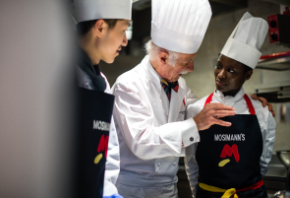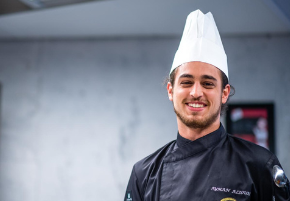- About
- Programs
- Campus Life
- Career Services
- Admissions
- News & Events
- Alumni
Fusion Cuisine: Key Elements, Types, and Benefits
Learn what fusion cuisine is, how chefs create it, and why it’s transforming the way we eat. Dive into its types, benefits, and global trends.
Key Takeaways
- Fusion cuisine is firmly established in both fine dining and everyday eats—appearing everywhere, from high-end restaurants to popular food trucks.
- Success in fusion cooking requires creativity and a strong foundation in traditional culinary techniques.
- Formal education helps chefs master fusion with skill, respect, and authenticity without compromising quality.
Ever tried a Korean taco or a sushi burrito? These flavor-packed creations are exciting examples of fusion cuisine, where culinary traditions from different cultures meet and mingle on a single plate.
What was once seen as a passing trend has become a major force in global gastronomy, fueled by curious diners and increasingly diverse communities. Over 55,000 restaurants have incorporated fusion dishes into their menu, and they're projected to increase in popularity overall this year compared to last year.
As chefs continue to blend ingredients and techniques across borders, this cuisine style is changing the way people experience food around the world. Therefore, understanding such an approach is now essential, not just for aspiring chefs but for food businesses looking to stay relevant and inspired as well.
Start Your Culinary Journey
Learn the art of cooking in a world-class environment
What Is Fusion Cuisine?
Fusion cuisine is a culinary style that combines elements from different cultural or regional cooking traditions to create innovative and unique dishes. It goes beyond simple ingredient mixing, often blending cooking techniques, presentation styles, and flavor profiles from multiple food cultures.
While fusion cuisine might seem like a modern invention, its roots run deep. Centuries ago, trade routes and colonization sparked the exchange of spices, ingredients, and techniques that began to reshape local cuisines.
One early example is Nikkei cuisine, a blend of Japanese and Peruvian flavors that emerged at the end of the 19th century with the arrival of Japanese immigrants in South America. Another is the Indo-Chinese cuisine developed in Kolkata, India, about 85 years ago, fusing Chinese cooking methods with Indian spices.
Today, fusion cuisine is celebrated for its creativity and inclusivity, allowing chefs to push culinary boundaries and showcase global influences in every dish.
Key Elements of Fusion Cuisine
At the heart of fusion cuisine are a few essential principles that guide chefs in creating dishes that are both exciting and respectful of their roots:
- Cultural blending: Fusion cuisine starts with a thoughtful merging of culinary traditions. It might pair the bold spices of Indian food with the delicate textures of Japanese cooking or combine Mexican street food with Korean barbecue. The goal is harmony, not confusion.
- Balance of flavors: Achieving the right flavor balance is essential. Fusion dishes must combine sweet, salty, sour, spicy, and umami elements in a way that complements both cuisines involved. Overpowering one tradition defeats the purpose.
- Ingredient innovation: Chefs often mix familiar and unexpected ingredients to create new flavor profiles. Think wasabi mashed potatoes or tandoori pizza. Creativity is key, but it must make sense on the palate.
- Respect for traditions: Authenticity matters. While fusion encourages innovation, honoring the roots of each culture's food keeps fusion meaningful and helps avoid cultural insensitivity.
Types of Fusion Cuisine Around the World
Different fusion cuisine styles exist around the world, each bringing a unique touch to the global culinary experience by blending diverse flavors, cooking techniques, and cultural influences into one harmonious dish.
Asian fusion
Asian fusion brings together culinary elements from different Asian regions or blends them with global cuisines. Popular combinations include Japanese-Korean, Thai-Chinese, or Japanese-Peruvian.
Nikkei cuisine is a standout style, resulting from the cultural and culinary exchange between Japanese immigrants and the existing Peruvian culinary landscape and culinary culture. Key ingredients include Shoyu (soy sauce), miso, hondashi, rocoto peppers, cilantro, and a variety of fish and seafood. Techniques like stir-frying, sushi rolling, and steaming are often adapted.
Another creative twist is the Korean taco, a fusion of Korean and Mexican cuisine. It typically features Korean staples like bulgogi, kimchi, and gochujang, paired with Mexican elements such as corn tortillas, cilantro, and lime. Common techniques include grilling marinated meats, quick pickling, and layering spicy-sweet flavors.
These dishes maintain the bold flavors and fresh ingredients of Asian cooking while adopting new forms, resulting in meals that are both rooted in tradition and inspired by global innovation.
Latin and American fusions
Latin and American fusion blends the bold spices and comfort foods of Latin and American cuisines with flavors and techniques from around the world. A prominent style is Chifa, a Chinese-Peruvian cuisine featuring fried rice with soy sauce, scallions, and Peruvian peppers.
Tex-Mex is a variation of Mexican cuisine that emerged from adaptations made in the bordering state of Texas, based on local food availability and preferences. This variation of Mexican food rapidly spread throughout the southwestern United States and today dominates the menus of most Mexican restaurants across the country. Key differentiating Tex-Mex ingredients include:
- Black beans
- Cheddar and jack cheeses
- Flour tortillas
- Chili powder
- Cumin
These fusions celebrate bold flavors and hearty meals, adapting traditional Latin dishes into formats familiar to American diners while keeping their distinctive zest and flair.
European and Asian fusions
European and Asian fusions offer an elegant mix of refined Western techniques and bold Asian flavors. French-Vietnamese cuisine is a standout, rooted in colonial history—think banh mi sandwiches with pâté and pickled vegetables or pho with hints of cinnamon and star anise.
Common pairings also include Italian-Japanese, seen in dishes like miso carbonara or sashimi with olive oil. Ingredients often include soy, garlic, butter, miso, noodles, and fresh herbs. Fusion cooking here emphasizes plating finesse, sautéing, and slow cooking.
The result is a delicate, flavorful marriage of East and West, balancing richness with freshness on every plate.
Modern Western fusions
Modern Western fusion is contemporary, often experimental, blending elements from global cuisines into Western-style dishes. It doesn't follow strict rules but prioritizes creativity. Think sushi burgers, kimchi mac and cheese, or Thai curry pizza.
Ingredients span from quinoa and kale to sriracha, gochujang, or tahini. Chefs often mix cooking styles, like baking with steaming or roasting with marinating in global spices. This style thrives in cosmopolitan cities and is best enjoyed through food trucks, where multicultural influences shine.
The focus is on reinvention and accessibility, merging familiar comfort foods with international flair to surprise the palate while remaining visually appealing and fun to eat.
African fusion
African fusion cuisine mixes indigenous African ingredients with global cooking styles to reimagine traditional dishes. North African flavors like harissa, preserved lemon, and couscous often blend with French or Mediterranean techniques.
Sub-Saharan African fusions use staples like yams, plantains, peanuts, and spicy stews, reinterpreted in Caribbean or European forms. For example, peanut butter chicken with rice pilaf or jollof-inspired risottos. Slow cooking, grilling, and braising are key techniques.
These fusions elevate hearty, home-style African meals while preserving bold spices and earthy richness. It's a prominent style in global kitchens, offering deep flavors and a strong cultural narrative.
Middle Eastern fusion
Middle Eastern fusion infuses global cuisines with the region's fragrant spices and traditional dishes. It often pairs Lebanese, Persian, or Turkish ingredients with French or American techniques.
Dishes like za'atar-spiced lamb burgers, tahini Caesar salads, or falafel tacos are popular. Key ingredients include sumac, saffron, chickpeas, pomegranate, and yogurt. Roasting, baking, and stewing dominate cooking methods.
Middle Eastern fusion emphasizes warmth and hospitality, adapting ancient recipes to modern contexts. The result is food that feels both familiar and exotic, honoring tradition while creating fresh, exciting dining experiences for new generations of food lovers.
Benefits and Challenges of Fusion Cooking
Fusion cuisine is where tradition meets innovation—a culinary crossroads where global flavors collide to create something entirely new. At its best, fusion cooking is a celebration of creativity, transforming familiar ingredients and techniques into bold, unexpected experiences that resonate with increasingly adventurous diners. But while the rewards can be deliciously high, so are the stakes.
Benefits
Fusion cooking encourages chefs to explore and innovate, offering a range of benefits:
- Creative freedom: Chefs can blend diverse ingredients and techniques, crafting unique dishes that transcend traditional boundaries.
- Broader appeal: By combining familiar elements from different cuisines, fusion dishes can attract a wider range of diners.
- Culinary innovation: Fusion encourages new food trends and redefines classic formats, like sushi burritos or ramen burgers.
Challenges
At the same time, fusion cuisine comes with its own set of difficulties:
- Cultural insensitivity: Without proper research and respect, fusion dishes can inadvertently misrepresent or appropriate cultural elements.
- Flavor imbalance: Not all ingredients work well together. Combining ingredients from different cuisines requires careful consideration to ensure harmonious flavors.
- Technical difficulties: Merging distinct cooking methods and ingredients can be complex and may lead to inconsistent results if not executed carefully.
How Chefs Create Successful Fusion Dishes
Creating successful fusion dishes takes more than creativity—it requires a solid foundation in culinary arts and a deep respect for the traditions being combined. Studying at the Culinary Arts Academy Switzerland (CAAS), ranked as one of the top culinary schools in Switzerland, provides aspiring chefs with both the technical skills and cultural insight needed to innovate with intention.
Our Bachelor of Arts in Culinary Arts program offers a comprehensive education, blending hands-on kitchen training with academic coursework in culinary theory and business acumen.
As student Alia Benamour shares, what sets CAAS apart is its focus on preparing students not only as chefs but also as future leaders in the industry:
I knew even before I came to Switzerland that Culinary Arts Academy was the best school for me, and now 3 years later, I can confirm!
The process of crafting fusion cuisine involves several critical steps:
- Research: Understanding the cultural and historical contexts of the cuisines being fused to avoid stereotypes or inaccuracies.
- Experimentation: Testing combinations of flavors, ingredients, and techniques to find harmonious blends.
- Tasting: Critically evaluating the balance and depth of flavors in trial dishes.
- Refinement: Adjusting recipes based on feedback and personal judgment to perfect the final dish.
Chef Roy Choi, known for his Korean-Mexican fusion at Kogi BBQ, captures the heart of fusion cooking, stating:
Cooking is not a craft to get into for money... you must get into it for the craft and the culture.
At CAAS, students learn exactly that—how to create with purpose, blending flavors from around the world while honoring the stories behind them.
Fusion Cuisine in Modern Restaurants
Fusion cuisine has evolved far beyond its experimental roots. Once seen as a novelty, it's now firmly established in both fine dining and everyday eats—appearing everywhere, from high-end restaurants to popular food trucks.
One major trend is the rise of creative street food, such as Korean tacos, sushi burritos, or Indian-inspired burgers. These dishes are not only bold in flavor but also perfect for social media: colorful, unique, and highly shareable.
On the fine dining side, chefs are elevating fusion to new heights. At Odette in Singapore, Julien Royer fuses French techniques with Asian ingredients to create dishes that are both inventive and deeply nuanced. In the U.S., Susanna Foo helped bring Chinese-French fusion into the spotlight, reshaping how diners experience both cuisines.
Global Flavors on One Plate
Fusion cuisine brings the world together on a plate, uniting flavors, techniques, and traditions into something exciting and new. From street food favorites to fine dining masterpieces, it reflects creativity, cultural respect, and global curiosity.
For those looking to explore fusion cuisine, studying at CAAS offers the training needed to approach fusion cuisine with both skill and sensitivity. With programs like the Bachelor of Arts in Culinary Arts, students learn to transform global inspiration into thoughtful, standout dishes that celebrate diversity through flavor.
Frequently Asked Questions (FAQs)
What is the world's first fusion cuisine?
Macanese cuisine is regarded as the world's first fusion cuisine, blending African, Indian, Southeast Asian, and Chinese flavors with Portuguese influence.
Who invented fusion cuisine?
Fusion cuisine doesn't have one inventor; it evolved naturally as cultures mixed through trade, migration, and colonization.
Are there risks in mixing cuisines?
Yes, without proper knowledge, fusion can result in clashing flavors or cultural insensitivity, which is why formal training in culinary arts is essential for respectful and successful combinations.
Interested in becoming a world-class chef? Learn more about Culinary Arts Academy Switzerland.





























